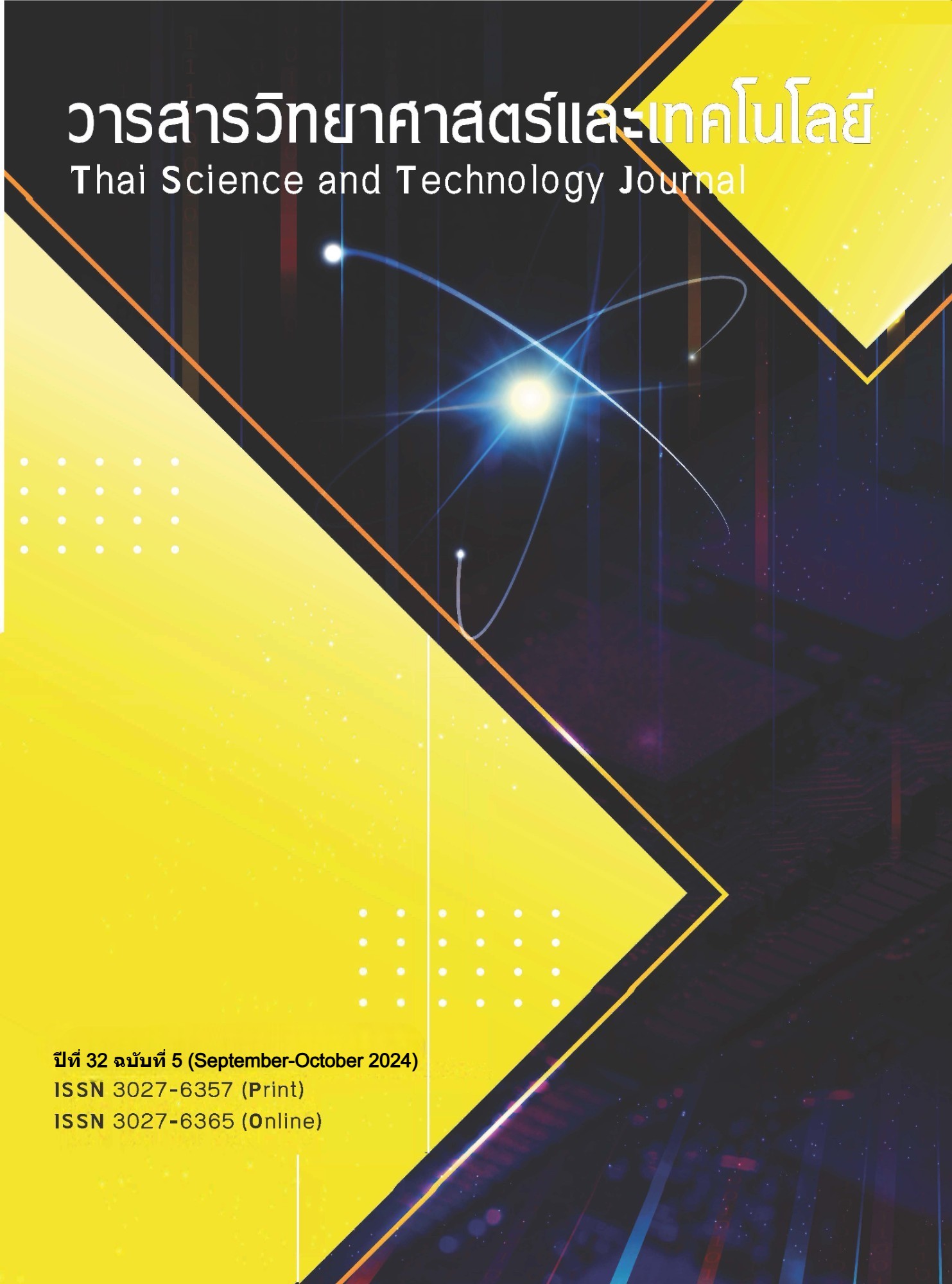The Study of 3D Modelling of Peltophorum Pterocarpum with Terrestrial Laser Scanner
Main Article Content
Abstract
The creation of three-dimensional models using a terrestrial laser scanner is a method of collecting data on objects and structures. By employing this technique, the distance between the instrument and objects is determined based on the travel time of laser light, resulting in the representation of three-dimensional coordinate points known as a "point cloud". In this study, this technology wasused tocollect dataonnine Peltophorum Pterocarpum trees at Kasetsart University. The study found that the three-dimensional models of the Peltophorum Pterocarpum trees could accurately depict the trunk and canopy, including cross-sectional profiles of the entire trunk. The basal area at breastheight, derived from the 3D model, was compared withfour different methods: the caliper method, automatic DBH by the 3D Forest program, tree contour tape measurements, and tape measurements along the convex shape.The results indicated that there was no statistically significant difference betweenthe basal area calculated from thecaliper method and the automatic DBH by the 3D Forest program when compared to the reference data (p>0.05). Furthermore, the heightof the trees was measured using botha 3D model and a total station, and the averageheight obtained from both methods did not show any significant differences (p>0.05). These three -dimensional models can be used to compare growth patternsor changes in each tree over the years. Additionally, this research can guide further studies in accurately assessing the dimensions of trees with high precision.
Article Details
References
Mahasuwanchai, P., Athisakul, C., Sairuamyat, P., Tangchirapat, W., Leelataviwat, S. and Chucheepsakul, S., 2021, An Alternative Method for Long-Term Monitoring of Thai Historic Pagodas Based on Terrestrial Laser Scanning Data: A Case Study of Wat Krachee in Ayutthaya, Adv. Civ. Eng. 2021: 1-17.
Manajitprasert, S., Tripathi, N.K., Arunplod, S., 2019, Three-Dimensional (3D) Modeling of Cultural Heritage Site Using UAV Imagery: A Case Study of the Pagodas in Wat Maha That, Thailand. Appl. Sci. 9(18): 3640.
Calders, K., Adams, J., Armston, J., et al. 2020, Terrestrial Laser Scanning in Forest Ecology: Expanding the Horizon. Remote Sens. Environ. 251: 1-17.
Chuopkhunthod, W., & Viphasa, C., 2020, Assessing the Risk Level of Urban Trees with Ground-based Laser Scanner Technology, pp. 1-6, Proceeding the National Civil Engineering Conference, Chonburi. (in Thai)
Wang, D., Liang, X., Mofack, G. and Martin-Ducup, O., 2021, Individual Tree Extraction from Terrestrial Laser Scanning Data via Graph Pathing, For. Ecosyst. 8(67): 1-11.
Trochta, J., Krucek, M., Vrška, T., Král, K., 2017, 3D Forest: An Application for Descriptions of Three-dimensional Forest Structures using Terrestrial LiDAR. PLoS ONE 12(5): 1-17.
Phungphong, N., Yingdee, J., Rianthakool, L. and Chumsangsri, T., 2023, 3D Model of Teak Log at Faculty of Forestry, Kasetsart University using Terrestrial Laser Scanner Survey, The 61st Kasetsart University Annual Conference, Kasetsart University, Bangkok, p. 756-764. (in Thai)
Eto, S., Masuda, H., Hiraoka, Y., Matsushita, M. and Takahashi, M., 2020, Precise Calculation of Cross Sections and Volume for Tree Stem using Point Clouds. The International Archives of Photogrammetry, Remote Sensing and Spatial Information Sciences, p. 205–210.
Pfeifer, N., and Winterhalder, D., 2012, Modelling of Tree Cross Sections from Terrestrial Laser-Scanning Data with Free-Form Curves. International Archives of Photogrammetry, Remote Sensing and Spatial Information Sciences, p. 76-81.
Faro, 2020, Scene 2019 Faro Focus Laser Scanners Training Workbook. Faro Technologies, 338 p.
Thailand Greenhouse Gas Management Organization (Public Organization), 2016, Reference Guide for the Development of Voluntary Greenhouse Gas Reduction Projects According to Thailand's Standards in the Field of Forestry and Agriculture, Thailand Greenhouse Gas Management Organization (Public Organization), Bangkok, 64 p. (in Thai)
Wiriyabancham, C., 2020, Handbook of Permanent Plot Placement and Field Data Collection, Forest Ecosystem and Environmental Research Group, Forest and Plant Conservation Research Office, Department of National Parks, Wildlife and Plant Conservation, Bangkok, 90 p. (in Thai)
Department of National Parks, Wildlife & Plant Conservation, 2017, Forest Resource Survey Guide, Forest Resource Survey Group Forest Resources Survey and Analysis Division Bureau of Conservation Area Restoration and Development, Department of National Parks, Wildlife and Plant Conservation, Bangkok, 59 p. (in Thai)
Pusztai, P., 2021, The Advantage of Point Cloud Derived Tree Modelling on Urban Greenery Maintenance: Shortlisting Dangerous Trees, Assessing Ecosystem Services, Master Thesis, Universidad del País Vasco, Spain, 63 p.
Warner, A. J., Jamroenprucksa, M., & Puangchit, L., 2017, Buttressing Impact on Diameter Estimation in Plantation Teak (Tectona grandis L.f.) Sample Trees in Northern Thailand, Agr. Nat. Resour. 51(6): 520-525.
Xu, W., Su, Z., Feng, Z., Xu, H., Jiao, Y., & Yan, F., 2013, Comparison of Conventional Measurement and LiDAR-Based Measurement for Crown Structures, Comput Electron Agric. 98: 242-251.
Krautz, N., 2019, Comparison of TLS to Total Station Accuracy for Tree Parameter Measurement in Biomass Estimation, Faculty of Health, Bachelor of Spatial Science (Honours) (Surveying), University of Southern Queensland, Australia, 49 p


